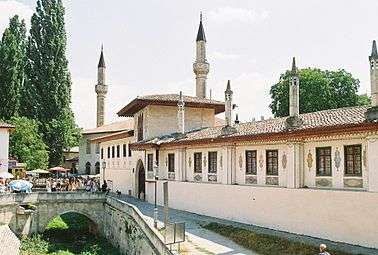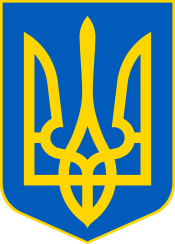Islam in Ukraine
Islam is the fourth-largest religion in Ukraine, representing 0.6%–0.9% of the population.[1][2] The religion has a long history in Ukraine dating back to the establishment of the Crimean Khanate in the 15th century.
Sunni Islam of the Hanafi school is the largest non-Christian religion in Ukraine, and the majority of Ukrainian Muslims are Crimean Tatars. Other Turkic peoples indigenous to Ukraine, predominantly found in South and south-east Ukraine, practice other forms of Islam. These include Volga Tatars, Azeris, North Caucasian ethnic groups and Uzbeks.[2] In 2012 an estimated 500,000 Muslims lived in Ukraine, including 300,000 Crimean Tatars.[3] In February 2016 Said Ismagilov, the mufti of Ummah, counted one million Muslims in Ukraine.[4]
While there is no general governing structure for Muslims in Ukraine, mono-ethnic communities in multi-ethnic regions are served by their ethnic institutions and supported by their international counterparts. The major Islamic institutions supporting communities are found in Kiev, Crimea, Simferopol and Donetsk. Independent Salafi communities are also found in Kiev and Crimea, as well as Shia communities in Kiev, Kharkiv and Luhansk.[2]
History of Muslims in Ukraine
While ethnic Ukrainians are predominantly Orthodox and Uniate Christians, Muslims have lived in the territory that makes up modern Ukraine for centuries. Muslim settlements are concentrated in the country's southern half, particularly in Crimea, although there are Lipka Tatars colonies in other regions such as Volhynia and Podolia.
The history of Islam in Ukraine is associated with the Crimean Tatars, the Turkic speaking descendants of Turkic and non-Turkic peoples who had settled in Eastern Europe as early as the 7th century. They established the Crimean Khanate in southern Ukraine in the 15th century. The Khanate soon lost its sovereignty and fell under the influence of the Ottoman Empire, although its local rulers retained a significant degree of autonomy. From the 15th to the 18th centuries, Crimean Tatars frequently raided Eastern Slavic lands to capture their inhabitants, enslaving an estimated three million people, predominantly Ukrainians.[5][6][7][8] The Khanate ended after growing Russian influence led to its annexation into the Russian Empire after the Russo-Turkish Wars in the late 18th century.
The Crimean Tatars were Sunnis, and their mufti was regarded as the highest religious figure. Tatar communities were led and represented by local imams.
At the time the Khanate was annexed by Russia, its capital of Bakhchysarai had at least 18 mosques along with several madrassas. However, the Russian Empire began persecuting the Muslim population, and nearly 160,000 Tatars were forced to leave Crimea.
20th century
At the time of the Russian Revolution in 1917, Muslims constituted one-third of Crimea's population. Nearly all major cities in Crimea had significant Muslim populations.
Crimean Muslims were subjected to mass deportation in 1944 when Joseph Stalin accused them of collaborating with Nazi Germany. More than 200,000[9] Crimean Tatars were deported to Central Asia, primarily the Uzbek SSR. It is estimated that more than 100,000 deportees died of starvation or disease due to the deportation.[10] The property and territory abandoned by Crimean Tatars was appropriated by the mostly ethnic Russians who were resettled by the Soviet authorities, leading to large demographic changes in Crimea. Although a 1967 Soviet decree removed the wartime collaboration charges against Crimean Tatars, the Soviet government did nothing to facilitate their resettlement in Crimea, and the repatriation of Crimean Tatars to their homeland only began in 1989.
Ukrainian Muslims today
Since the Ukrainian independence in 1991, the return of Crimean Tatars to Crimea has increased compared to the Soviet era. Although Ukraine's Muslim population consists of various ethnic groups, the majority are of Tatar origin. There has also been a proportionally small settlement of Muslim Chechen refugees in Crimea and other parts of Ukraine.
Muslims in Ukraine have 445 communities, 433 ministers, and 160 mosques, with many more mosques currently being built.[11]
Estimates of the Ukrainian Muslim population vary. Muslims make up only approximately 0.9% of the Ukrainian population, but as much as 12% in Crimea. According to the 2000 census Ukraine was home to 248,193 Crimean Tatars, 73,304 Volga Tatars, 45,176 Azeris, 12,353 Uzbeks, 8,844 Turks, 6,575 Arabs and 5,526 Kazakhs.[12][13] The 2012 Freedom Report estimating a Muslim population of 500,000 in Ukraine, including 300,000 Crimean Tatars.[3] A 2011 Pew Forum study estimated a Ukrainian Muslim population of 393,000,[14] but the Clerical Board of Ukraine's Muslims claimed there were two million Muslims in Ukraine as of 2009.[15] According to Said Ismagilov, the mufti of Ummah, in February 2016 one million Muslims lived in Ukraine.[4]
Muslims have formed three structures for running their affairs. These are:
- Clerical Board of Ukraine's Muslims
- The Spiritual Centre of the Muslim Communities
- Clerical Board of Crimea Muslims
- Religious Administration of Muslims of Ukraine
Most Ukrainian Muslims affiliate to these organizations, which help them join mainstream Islamic and Ukrainian daily life. There are nearly 360 registered Ukrainian Muslim communities and organizations, and at least 30 communities work without official registration. Attempts to create a Ukrainian Muslim political party led to the creation of the Party of Muslims of Ukraine, but its registration certificate was cancelled in November 2011 because it had not nominated candidates in elections since the 1998 parliamentary elections.[16] Muslims have also formed several charitable organizations, including the CAAR Foundation, Al-Bushra, and Life after Chornobyl. Arraid (The Interregional Association of Public Organizations) is another Muslim organization which has gained notable attention.
An advance copy of first complete translation of the Quran into Ukrainian was released in Saudi Arabia in 2012.[17]
Due to the 2014 Russian annexation of Crimea and the War in Donbass, which is fought near Donetsk and Luhansk, 750,000 Muslims (including half-million Crimean Tatars) are living in territory no longer controlled by Ukraine.[4] (According to figures as stated by Said Ismagilov, the mufti of Religious Administration of Muslims of Ukraine "Ummah".[4])
Gallery

 Fountain of Tears is known as the embodiment of love of one of the last Crimean Khans, Qırım Giray Khan for his young wife a Polish girl in his harem. Despite his battle-hardened harshness, he was grievous and wept when she died.[18]
Fountain of Tears is known as the embodiment of love of one of the last Crimean Khans, Qırım Giray Khan for his young wife a Polish girl in his harem. Despite his battle-hardened harshness, he was grievous and wept when she died.[18]- Mosque of Öz Beg Khan built in Crimea in 1314.
 Ancient Column with Persian inscription, at the Livadiya Palace in Yalta, Crimea, Ukraine.
Ancient Column with Persian inscription, at the Livadiya Palace in Yalta, Crimea, Ukraine. Crimean Tatar patio and garden courtyard, at the Livadiya Palace, Crimea, Ukraine.
Crimean Tatar patio and garden courtyard, at the Livadiya Palace, Crimea, Ukraine. Mosque in Ukraine
Mosque in Ukraine
See also
- Ochakiv
- Mustafa Abdülcemil Qırımoğlu
References
- Соціологічне опитування - Релігія: Віруючим якої церкви, конфесії Ви себе вважаєте? [Sociological survey - Religion: Believers, which churches do you consider yourself to adherents of?]. Razumkov Centre (in Ukrainian). 2006. Archived from the original on 8 April 2014. Retrieved 27 May 2016.
- Yarosh, Oleg; Brylov, Denys (2011). "Muslim communities and Islamic network institutions in Ukraine: contesting authorities in shaping Islamic localities". In Katarzyna Górak-Sosnowka (ed.). Muslims in Poland and Eastern Europe: Widening the European Discourse on Islam. Katarzyna Górak-Sosnowska. pp. 252–265. ISBN 978-83-903229-5-7.
- "2012 Report on International Religious Freedom - Ukraine". United States Department of State. 20 May 2013. Retrieved 16 December 2013.
- Ukrainian Muslims root for Ukraine, Kyiv Post (11 February 2016)
- Matsuki, Eizo (March 2006). "The Crimean Tatars and their Russian-Captive Slaves: An Aspect of Muscovite-Crimean Relations in the 16th and 17th Centuries" (PDF). Mediterranean world. Hitotsubashi University, Mediterranean Studies Group. 18: 171–182. Archived from the original (PDF) on 5 June 2013.
- Kizilov, Mikhail. "Slave Trade in the Early Modern Crimea From the Perspective of Christian, Muslim, and Jewish Sources". Oxford University. pp. 2–7.
- Andrew G. Boston (18 April 2005). "Black Slaves, Arab Masters". Frontpage Magazine. Archived from the original on 9 December 2006. Retrieved 8 January 2011.
- Alan Fisher, Muscovy and the Black Sea Slave Trade – Canadian American Slavic Studies, 1972, Vol. 6, pp. 575–594
- Pohl, Otto J. (April 2000). The Deportation and Fate of the Crimean Tatars. 5th Annual World Convention of the Association for the Study of Nationalities: "Identity and the State: Nationalism and Sovereignty in a Changing World". Columbia University, New York. Retrieved 26 May 2016.
- "To the 71st Anniversary of Crimean Tatars deportation - Publications - Embassy of Ukraine in the Kingdom of Thailand". mfa.gov.ua.
- "Spiritual Administration of Muslims of Ukraine". Archived from the original on 31 January 2009. Retrieved 12 December 2010.
- "About number and composition population of Ukraine by data: All-Ukrainian population census 2001 data". State Statistics Committee of Ukraine. 2003. Retrieved 17 April 2017.
- Інші національності за даними переписів населення [Other nationalities according to population data from censuses] (in Ukrainian). State Statistics Committee of Ukraine. 2003. Retrieved 17 April 2017.
- "The Future of the Global Muslim Population". pewforum.org. 27 January 2011.
- Ислам в Украине [Islam in Ukraine]. Islamyat.org (in Russian). 26 June 2009. Archived from the original on 5 December 2011. Retrieved 5 December 2011.
- Lavrynovych: Court cancels registration certificates of five Ukrainian parties, Kyiv Post (29 November 2011)
- "Advance copy of first complete translation of Quran in Ukrainian released in Saudi Arabia". Ukrinform. Ukrinform. Retrieved 23 March 2015.
- Johnstone, Sarah. Ukraine. Lonely Planet, 2005. ISBN 1-86450-336-X
External links
| Wikimedia Commons has media related to Islam in Ukraine. |
- http://risu.org.ua/en/index (Religious information service of Ukraine)
- http://gazeta.arraid.org (Ukrainian Muslims Newspaper ARRAID)
- http://www.islam.in.ua (News & publicist site about Islam & Muslim in Ukraine)
- https://web.archive.org/web/20090131210406/http://islamyat.org/ Clerical Board of Ukraine's Muslims website
- Crimean Tatar Internet Resources
- Crimean Tatars Short History
- Ukrainian translations of the Meanings of the Glorious Qur'an: Problems and Prospects. An article by Mykhaylo Yakubovych
- Yakubovych, Mykhaylo 'Islam and Muslims in Contemporary Ukraine: Common Backgrounds, Different Images', Religion, State and Society, September 2010, 38:3, 291 - 304

.jpg)
